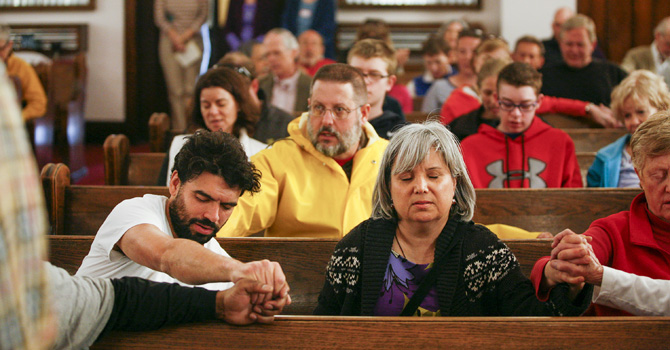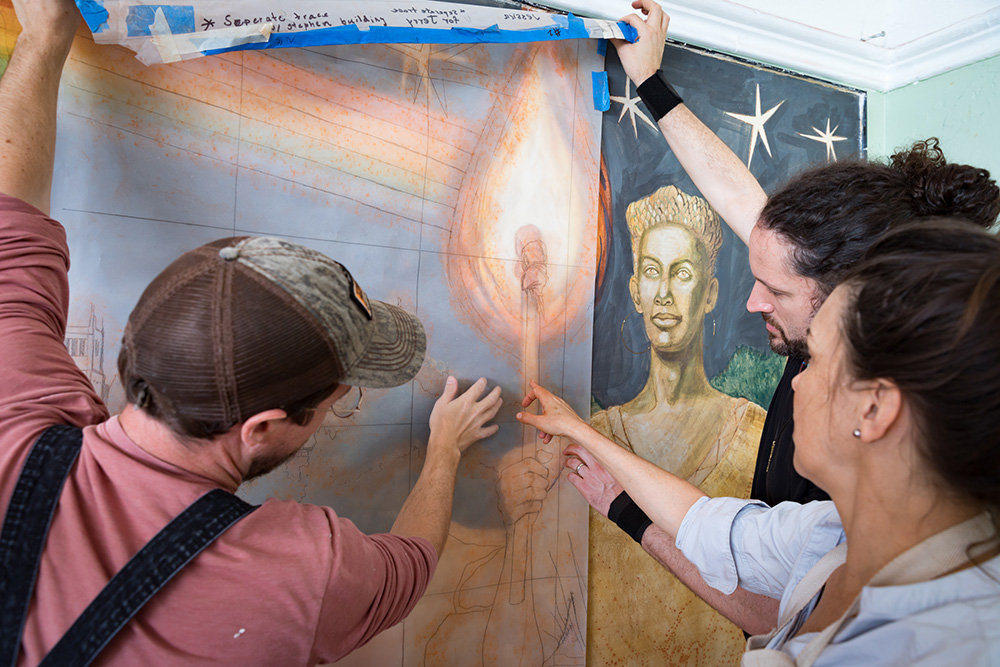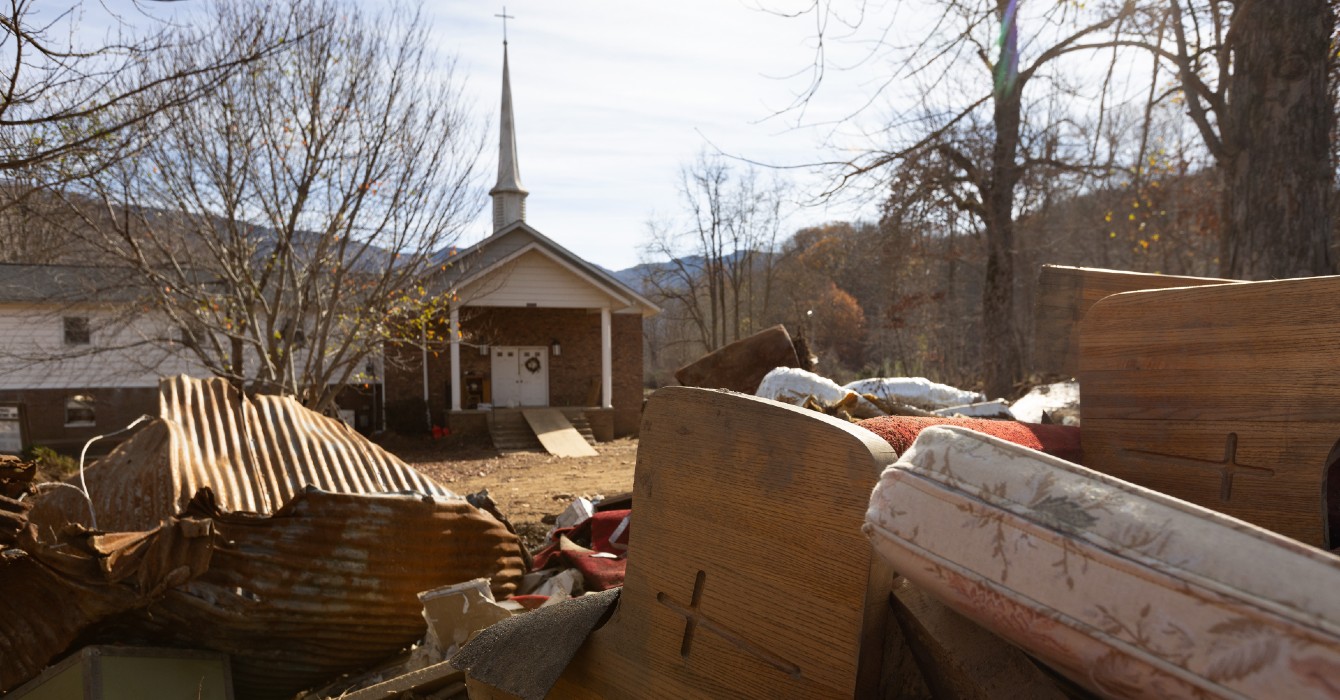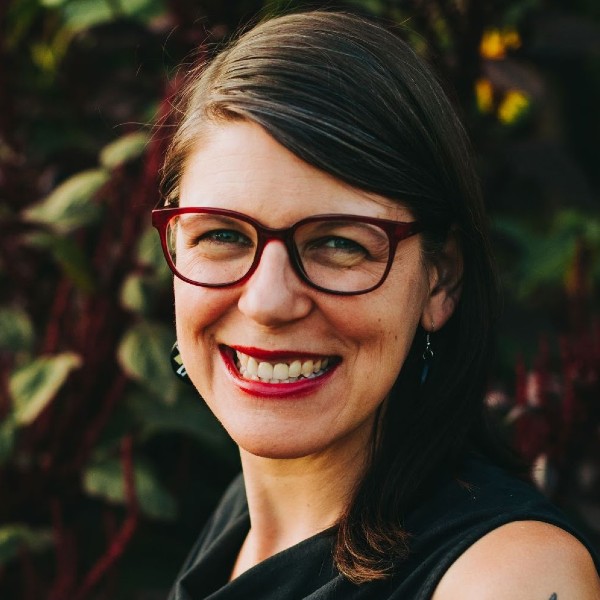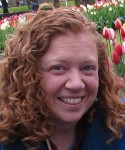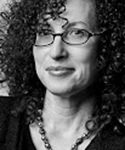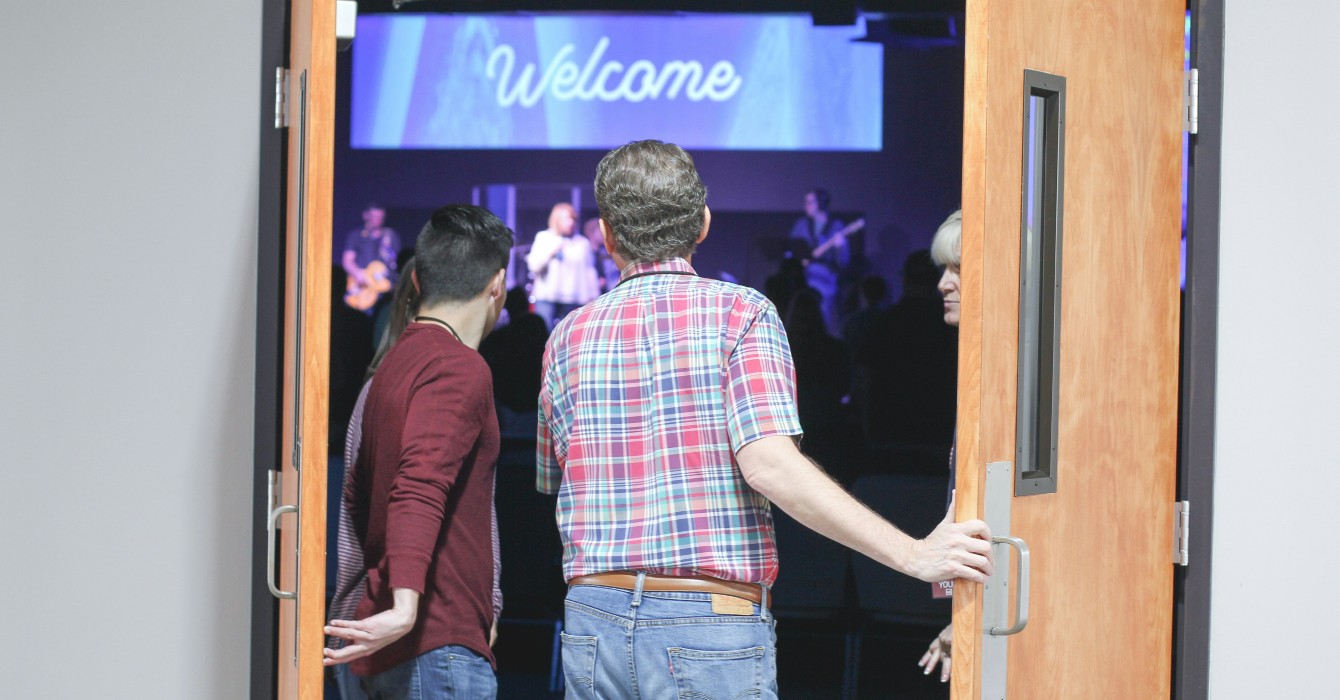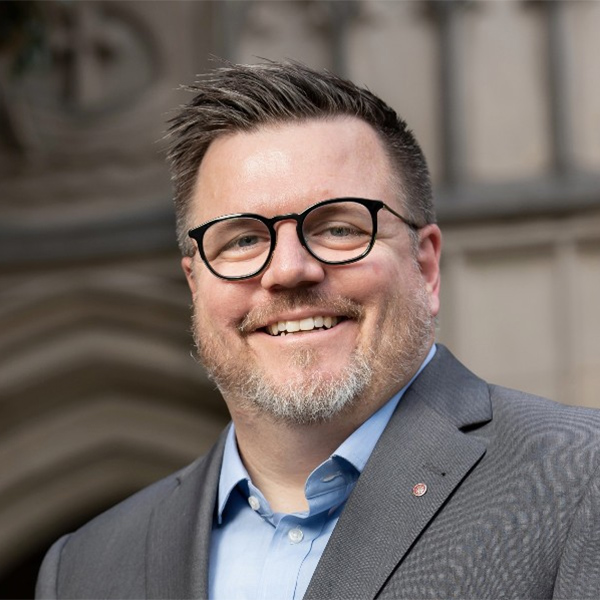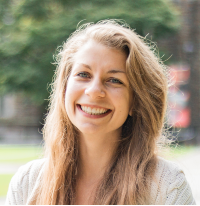On a cold, rainy day in early March, a 30-something man walked into the sanctuary at the Haywood Street Congregation for the Wednesday midday service with a shaggy mixed-breed dog on a leash. Dark-haired and bearded, dressed in a brown T-shirt and army-green painter’s pants, the man looked like a dozen other young guys you might encounter in downtown Asheville, North Carolina.
But he wasn’t just another guy. He was the pastor, the Rev. Brian Combs, and the dog was Penny, the Haywood Street “church dog.” As the two made their rounds, greeting congregants, organist Edward Smith launched into “Nobody Knows the Trouble I’ve Seen.” Moments later, assistant pastor Darryl Dayson -- young, dreadlocked and wearing jeans -- stepped up onto the chancel and welcomed everyone, inviting them to “join in creating community.”

On that day, as on every other Wednesday, the created community at Haywood Street was a rare and stunning mix -- many homeless and some “housed,” Christians and Jews, pastors and parishioners from other churches, black and white, young and old, families and single people, gay and straight, sober and … (for a few) maybe not so much. And Penny wasn’t the only dog.
Known as a church of “holy chaos,” the Haywood Street Congregation is a United Methodist mission church that was launched in 2009 as a place of welcome and ministry for people who are homeless or otherwise living on the margins in downtown Asheville. In addition to the Wednesday worship service, the church offers a long list of programs, including recovery groups, Bible studies, AA meetings, a clothing closet, a community garden and an eight-bed respite-care unit for homeless people who need a place to recuperate after a hospital stay.

All this is bursting forth in a building that was formerly home to Haywood Street United Methodist Church, a long-struggling congregation that was closed in 2006 and merged into Central UMC a few miles away. At a time when mainline churches and their leaders are searching for new ways to do and be church, Haywood Street is an example of entrepreneurial and innovative ministry happening within a large denomination.

“This doesn’t fit any molds,” said the Rev. Larry Goodpaster, the bishop of the UMC’s Western North Carolina Annual Conference. “Brian has demonstrated for the whole church a model -- not the only model, but a model -- of how to be engaged with those whom society has forgotten. We knew early on that this was going to be different.”
Taking risks in the name of God
And different it is. Haywood Street Congregation is a church plant that doesn’t look like a typical church plant. It’s a church that doesn’t worship on Sundays. It’s a hybrid of sorts -- part church, part nonprofit, with a full-time executive director who spends much of her time on grant writing and other fundraising efforts. And it is a church that is supported financially and otherwise by other churches and organizations throughout Asheville and, increasingly, all of western North Carolina.
“I look at it now, and it’s a beautiful story of church in the world, inviting everybody in, and it’s fascinating,” said the Rev. John Boggs, the district superintendent for the conference’s Blue Ridge District. “But in the beginning, it wasn’t clear how we would do this.”
The one thing that was clear to Boggs and Goodpaster was Combs’ passion for ministry to people on the margins.
“We didn’t know what it would look like, but we knew there was an opportunity to demonstrate what the Great Commandment was all about,” Goodpaster said. “What caught my attention was Brian’s passion and willingness to take risks in the name of Christ and to experiment.”
 Combs, 37, came to ministry following a short and unsatisfying career in industrial design. After receiving his M.Div. at Emory University’s Candler School of Theology, he did chaplaincy training at Grady Memorial Hospital in Atlanta, a large public hospital that serves a significant proportion of the city’s low-income residents. Working in the hospital and on Atlanta’s streets, he ministered to people who were homeless, people who were mentally ill, people who were dying from AIDS, people who were struggling with addictions.
Combs, 37, came to ministry following a short and unsatisfying career in industrial design. After receiving his M.Div. at Emory University’s Candler School of Theology, he did chaplaincy training at Grady Memorial Hospital in Atlanta, a large public hospital that serves a significant proportion of the city’s low-income residents. Working in the hospital and on Atlanta’s streets, he ministered to people who were homeless, people who were mentally ill, people who were dying from AIDS, people who were struggling with addictions.
Who is the Jesus that you know? How does that shape your understanding of ministry?
“It was a revelation for me,” Combs said. “I was experiencing Jesus, God incarnate, as Howard Thurman would say. Jesus came as a homeless vagrant. This was a Jesus I had never met, and once I encountered him, I was convicted in a way I had never been before.”
Combs had found his calling.
Returning to his home conference in western North Carolina in 2007, he asked to be assigned to do similar work, but few if any such jobs existed in the mostly rural region.
“The cabinet responded, as most would, ‘We don’t have anything like that,’” Combs said.

Instead, Combs was sent to rural Haywood County, just outside Waynesville, to serve as pastor to two small, declining congregations.
It was a poor fit for a pastor called to urban ministry. Before long, Combs felt isolated and became depressed. He considered leaving ministry.
“It was so contrary to everything I was called to,” he said.
In 2008, Combs began calling UMC conference offices in large cities across the country looking for a position in urban ministry, and was about to accept an appointment in Pittsburgh when he heard from Boggs, a pastor whom he had known for years. Formerly the pastor at Combs’ home church in Charlotte, Boggs had just been appointed as the district superintendent in Asheville, and had heard from his counterpart in Waynesville about a young pastor who wanted to do urban ministry. When he realized that the young pastor was Combs, he gave him a call.
“When I told [Boggs] that I was planning to leave for Pittsburgh, he told me to hold on,” Combs said.
Laying the groundwork
Combs and Boggs weren’t the only pastors in Asheville interested in ministry to people on the margins. The Rev. Rob Blackburn was as well.
Blackburn’s church, Central United Methodist, had merged with the declining Haywood Street UMC two years earlier. Central had kept the Haywood building open as a place for ministry, renting space to various nonprofits.

But Combs knew that Blackburn wanted to do more, and the two pastors began talking about the possibility of using Haywood’s building as a place for Combs to launch his ministry. In a pivotal meeting, they had lunch with Bishop Goodpaster and talked about Combs’ vision for ministry in Asheville.
Goodpaster was excited, and agreed to support the proposal.
“The excitement was around Brian’s passion for ministry and the opportunity to be in mission,” Goodpaster said.
How comfortable are you with uncertainity, with not knowing the end result beforehand?
They all felt deeply called and committed to Combs’ vision but had no idea how they would make it a reality. When Boggs pointed out all the uncertainties and issues, from infrastructure to finances, Goodpaster had a ready response.
“Y’all are smart,” he told the pastors. “You’ll figure it out.”
So they forged ahead, not sure exactly where they were going.
“Sometimes, when you’re engaged in ministry, especially on the margins, you have to make it up as you go along,” Goodpaster said. “But you never lose sight of the mission, of loving God and neighbor.”

Take it to the streets
After Goodpaster appointed Combs to this yet-to-be-determined ministry, Combs spent six months on the streets, meeting people in homeless shelters and under bridges, talking and listening to them, asking them what they needed. What he heard would form much of what Haywood Street Congregation is today.
The Wednesday worship service, for example, came out of those conversations. Plenty of churches have services and meals on Sundays, people on the streets told Combs. But by midweek, things can go off the rails for people who are homeless or struggling from addiction.

Blackburn and the congregation at Central UMC also signed on, agreeing to let Combs use the Haywood building.
“Rob said, ‘Here’s the key to the building; it’s yours,’” Combs said. Though Central still owns the building, Haywood Street pays for the utilities and repairs.
Combs also spent much of that first year -- and every year since -- talking to churches, businesses and social service agencies throughout Asheville, sharing his vision for a ministry to the homeless.
“I knocked on every door I could and talked to anybody who would open it,” Combs said. “I felt a sense of desperation. I couldn’t not do this. There was no other calling for me. It was either this or I’m leaving ministry.”
After the first year, the district and the conference provided a $30,000 start-up grant from the United Methodist Asheville District Trustees and a $280,000 declining-balance grant from the Western North Carolina Conference Office of Congregational Development.
By the very nature of Haywood Street’s ministry, Combs and the others knew that financial sustainability would always be an issue. Unlike other churches, they could not look to members for donations but instead would always have to seek resources elsewhere. From the beginning, the church has essentially operated like a faith-based nonprofit, serving the community, building relationships and scrambling for funds.
Faith-based nonprofit
“It was important to claim our identity as a faith-based nonprofit organization in addition to being a church,” said Laura Kirby, the congregation’s executive director and a UMC deaconess. “What enabled us to be sustainable were our community partnerships and relationships. We have a huge interface with the whole community of Asheville.”

About three dozen congregations -- from United Methodist to Pentecostal, Catholic and Jewish -- play important roles at Haywood Street, providing financial, in-kind and volunteer support. The church also works with local housing agencies, health care providers, social service organizations, civic clubs, schools, restaurants, businesses and grocery stores.
All the relationship building has paid off. Since 2010, Kirby said, the church has been able to cover a growing percentage of the annual budget through its own fundraising efforts -- even as its ministries have expanded. Overall, the budget grew from $155,000 to $589,000 from 2010 to 2014, when the respite care area opened. Although the church continues to receive funds from the conference and district, those monies account for a much smaller percentage of the budget than just a few years ago.
Last year, almost 50 percent of the church budget came from donations from individuals, 15 percent from other churches, and 10 percent from businesses and special events. Conference and district funds, which accounted for 68 percent of the budget in 2010, now cover only about 15 percent.
In effect, the church has been able to reduce its financial dependence on the conference and district, at least in relative terms, Kirby said.
“What’s significant is that we’ve been able to do more without having to go back to the conference and ask for more money,” Kirby said.
Ministry on Wednesdays
All the numbers and dollars represent real ministries that happen every day at Haywood Street. But never, perhaps, are they more visible than on Wednesdays.

When the church held its first midweek service in November 2009, a handful of people attended. Now, 75 to 100 gather for worship, and 400 are served at the free meal.
The day starts with Story Circle, led by Barbara Bates Smith, a congregant and nationally recognized storyteller. Anyone who comes can share any story they like.
The first of three Welcome Table seatings starts at 10:30 a.m., but beforehand, people can get a haircut or a manicure or shop at the Clothing Closet.
The meals aren’t served soup-kitchen style. Instead, volunteers bring food to the tables, where it’s passed around family style. The food is excellent cuisine donated by some of Asheville’s best restaurants.
No one has to attend the service to get a meal; everyone is free to eat and leave. Even so, many stick around.

The service has some familiar elements, such as the Prayers of the People and offerings. But as the printed bulletin warns, “Today’s liturgy may be blown away by the Spirit at any moment.”
What would worship be like for you to be "blown away by the Spirit?"
On that day in early March, Combs’ “conversational homily” was about John 2:13-22, Jesus and the moneylenders in the temple. Combs talked about anger and asked the congregation whether anger is a Christian emotion.
As people raised their hands, Combs called on them by name. Many said they had struggled with anger. Eventually, the conversation shifted to the subject of righteous indignation, the kind of anger felt at the experience of injustice.
“Maybe that kind of anger is the kind that moves us to take positive action for change,” Combs said.
After the homily, a man in the front row became agitated, stood up and threw what he mistakenly thought was a Bible (actually a binder containing the bulletin) on the floor.
“We don’t need what’s in here,” the man said.
He talked briefly about how hard it had been to watch his father slip away from Alzheimer’s disease, and after rambling a bit, he stopped.
“We just need to love each other,” he said.
Combs touched his shoulder and leaned in supportively. The man calmed down, but Combs stayed near.

Growing uncomfortable
Outbursts aren’t unusual at Haywood Street, Kirby said: “Everyone knows that no matter what they say, it’s going to be accepted.”
People aren’t required to be sober in order to attend the services, which can lead to exchanges that many traditional congregants aren’t used to.
All the better, Combs said.
“Spiritual growth is dependent on being uncomfortable,” he said. “I’m unwilling to water down what we do here to make people of privilege more comfortable. Sometimes when people act out most is when you experience the most love. It’s in those moments of crisis that the Spirit shows up.”
How does your church challenge people and make them uncomfortable? What's the right balance between welcome and challenge?
As the word about Haywood Street has spread, the congregation has become a teaching model for other churches. Pastors, youth groups and church councils from across the region visit frequently, wanting to learn how they too can start such a ministry.
Combs is sometimes surprised by all the interest.
“People always say this is so novel,” he said. “But there is nothing new about what we’re doing. It’s as old as the gospel and Methodism. From day one, John Wesley was on the streets. This is Methodism 101. We’re nothing new. We’re a retread in every way.”
Questions to consider
Questions to Consider
- Who is the Jesus that you know? How does the answer to that question shape your understanding of ministry?
- Is your church or organization willing to “make it up” as it goes along? How comfortable is it with not knowing the result beforehand? Does that help or hurt ministry?
- How well does your church or organization listen to others? Whom is it asking, “What do you need?”
- What other congregations can your church partner with? What nonprofits and businesses? How would you make an inventory of potential partners?
- When have you felt “blown away by the Spirit” in worship? What was that like?
- Does your church challenge people and make them uncomfortable? How do you strike a balance between comfort and discomfort, welcome and challenge?

